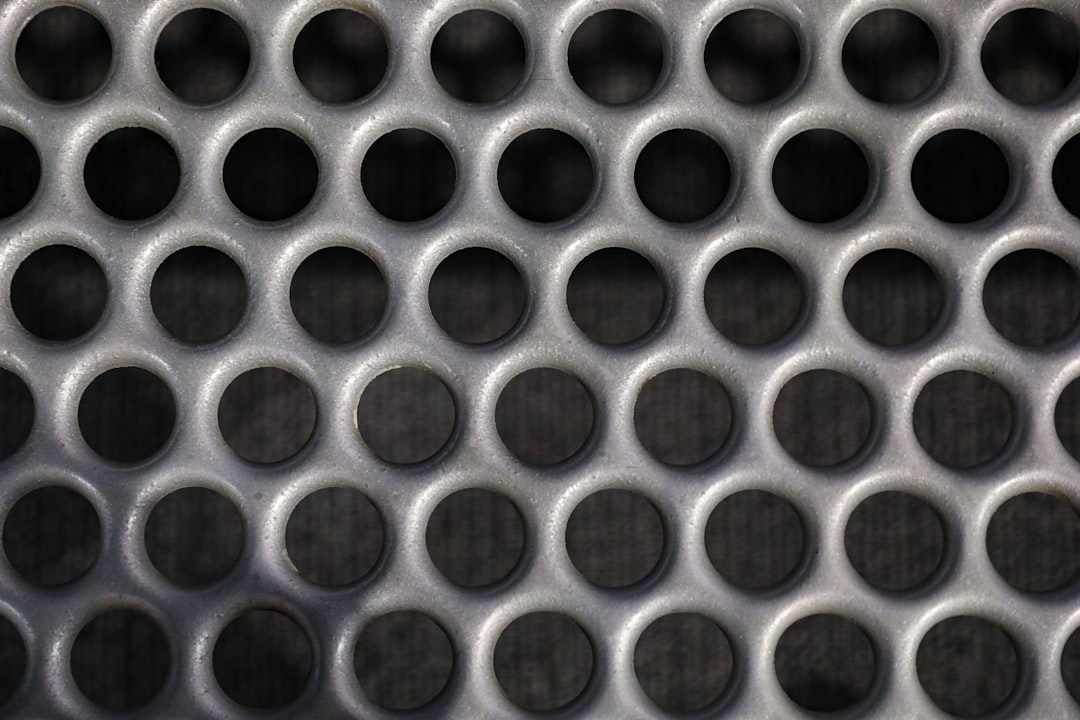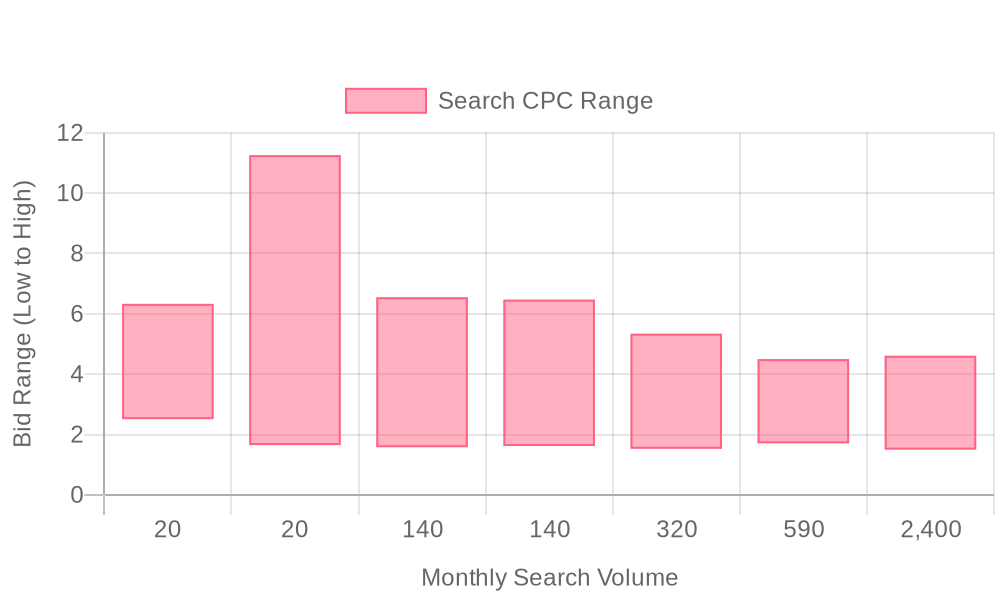
Supercharge your lead generation with a FREE Google Ads audit - no strings attached! See how you can generate more and higher quality leads
Get My Free Google Ads AuditFree consultation

No commitment
Supercharge your lead generation with a FREE LinkedIn Ads audit - no strings attached! See how you can generate more and higher quality leads
Get My Free Google Ads AuditFree consultation

No commitment
Supercharge your lead generation with a FREE Meta Ads audit - no strings attached! See how you can generate more and higher quality leads
Get My Free Google Ads AuditGet My Free LinkedIn Ads AuditGet My Free Meta Ads AuditFree consultation

No commitment
Supercharge your lead generation with a FREE Google Ads audit - no strings attached! See how you can generate more and higher quality leads
Get My Free Google Ads AuditFree consultation

No commitment
In today's dynamic marketing environment, aluminum fabrication companies face significant challenges in bridging online and offline efforts to capture high-intent leads efficiently. Waiting for traditional form fills or relying on generic website analytics can lead to delayed responses and missed opportunities. Advanced tools now allow businesses to proactively identify high-value accounts before conversion, enhancing targeting precision. Google Ads plays a pivotal role by allowing companies to reach decision-makers precisely when they're actively searching for solutions. This targeted approach is crucial, whether enhancing reach post-trade shows or complementing offline activities like direct mailing. By integrating digital inquiry opportunities with real-world sales through remarketing capabilities and thorough ROI measurement, businesses can ensure timely and relevant engagement with potential clients.

Aluminum fabrication companies operate in a market where every qualified lead represents significant project value and long-term partnership potential. Leveraging Google Ads allows these businesses to connect with decision-makers actively searching for precise fabrication capabilities, ensuring that marketing budgets drive measurable opportunities instead of wasted impressions. For a deeper dive on industry-specific tactics, review this overview of Google Ads strategies for manufacturing.
By integrating Google Ads into a multi-channel demand strategy, aluminum fabricators can continuously adapt to market shifts and rapidly evolving buyer behaviors. The following framework breaks down each stage of an effective Google Ads setup, from keyword strategies to audience segmentation, conversion optimization, and performance improvement, tailored to the unique needs of B2B manufacturers. For additional guidance, explore the Sona blog for actionable insights on B2B marketing and analytics.

Google Ads for Aluminum Fabrication Companies delivers a direct path to high-intent buyers who are seeking specialized services. Instead of waiting for organic traffic to materialize, paid search accelerates visibility for core capabilities—such as custom extrusions, precision welding, or architectural fabrication—at the exact moment prospects are ready to engage. This positions aluminum fabricators at the forefront of purchasing decisions and shortens the sales cycle by capturing demand at its peak.
Modern B2B marketing teams can leverage real-time insights from Google Ads to identify which search queries and landing pages are driving project requests or RFQs. With Sona Identification, marketers go beyond anonymous clicks, pinpointing which companies are researching specific fabrication services. This unlocks more personalized outreach and ensures ad spend is focused on accounts with true buying intent.
This campaign diversity allows aluminum fabricators to cover both direct lead capture and long-term brand reinforcement, improving both top-of-funnel awareness and bottom-of-funnel conversion rates. For a detailed breakdown of campaign types and recommendations, see this Google Ads guide for manufacturers.
Step 1: Build Targeted Keyword Lists
Begin with granular keyword research focused on high-conversion phrases relevant to your specific aluminum fabrication offerings. Group keywords by service type, industry application, and location to isolate the highest commercial intent. To supplement your research, use the ultimate guide to B2B marketing reports for data-driven decision-making.
Step 2: Structure Campaigns for Precision
Organize campaigns by service line, customer segment, or certification to match the way buyers search for fabrication partners. Use tightly themed ad groups for each major capability—like CNC machining, marine fabrication, or rapid prototyping—to maximize ad relevance and Quality Score. For advanced campaign structuring, review marketing plan templates for aluminum businesses.
Step 3: Activate Sophisticated Audience Targeting
Layer geographic, industry, and job function targeting to focus spend on procurement managers, engineers, and operations directors within your ideal regions. Real-time audience segmentation enables dynamic campaign updates, so you continuously align spend with the most engaged prospects as they move through the funnel.
Step 4: Optimize Landing Pages for Conversion
Design landing pages with clear value propositions, technical detail, and rapid quote forms. Incorporate proof points such as certifications, project photos, and lead forms tailored to key decision-makers. With visitor identification technology, you can personalize follow-up and route high-value inquiries directly to your sales engineers.
Step 5: Implement Advanced Conversion Tracking
Set up conversion goals for each stage of the buyer journey, including form fills, phone calls, and CAD file uploads. Integrate CRM and offline sales data to accurately attribute revenue to specific campaigns. Advanced conversion tracking enables you to understand the true ROI of Google Ads for Aluminum Fabrication Companies and adjust strategies to maximize cost-efficiency.
Step 6: Continuously Improve Performance
Conduct weekly reviews of keyword reports, ad copy, and landing page engagement. Use intent signals and conversion data to shift budget toward top-performing segments, ensuring you capture every actionable opportunity while minimizing wasted spend. Dynamic audience syncing across Google Ads and CRM ensures your campaigns always target the highest potential accounts based on live engagement signals.
This step-by-step guide empowers aluminum fabrication companies to capture qualified leads, enhance sales pipeline velocity, and build a sustainable competitive advantage through intelligent, data-driven Google Ads management. Ready to accelerate your pipeline? Get started for free with Sona.
Aluminum fabrication companies thrive on capturing demand from specialized buyers, where timing and technical expertise directly impact revenue growth. Precision in digital marketing allows these businesses to connect with procurement teams and engineers actively searching for solutions, ensuring every advertising dollar contributes to qualified lead pipelines. To maximize effectiveness, Google Ads strategies for manufacturing can be tailored to target niche audiences and drive higher quality leads.
Generic marketing can dilute budgets and overlook high-intent opportunities in fabrication, but Google Ads delivers measurable access to niche segments, such as commercial builders or OEMs seeking custom extrusions. With real-time audience targeting, companies can allocate spend toward regions or services where market demand surges, optimizing campaign ROI for fabrication-specific projects.
A unified approach to data and conversion tracking is critical as sales cycles lengthen and buyer journeys span multiple touchpoints. Closed-loop measurement ensures that every click, form fill, and phone inquiry is attributed back to the original ad, providing clear visibility into which campaigns drive true revenue outcomes. When sales and marketing teams operate from a single, enriched view of accounts and opportunities, they can act quickly on high-value signals—syncing leads into CRM and ad platforms for faster nurture and follow-up.
In dynamic B2B environments, visitor identification technologies go beyond anonymous web traffic, pinpointing which companies are evaluating fabrication capabilities. Access to these insights allows marketers to prioritize resources toward in-market buyers, adjusting bids and creative to match their level of intent. By keeping audiences dynamically updated as leads move deeper into the funnel, advertising strategies remain focused on those most likely to convert, supporting scalable growth for aluminum fabrication firms. To see how these strategies can accelerate your results, get started for free with Sona.

These campaign types, when coordinated, create a multi-touch digital marketing strategy for aluminum fabricators. By connecting ad performance data with CRM systems, companies can ensure that every campaign supports not just visibility, but measurable business outcomes and revenue growth. To see how this works in action, get started for free with Sona.

Aluminum fabrication companies operate in a rapidly evolving landscape where winning new business depends on precision targeting and a deep understanding of shifting demand. Growth is unlocked by leveraging intent-based segmentation and uncovering underserved verticals, allowing teams to capture accounts that align with their unique technical capabilities and service offerings. Sophisticated keyword research and industry-focused market analysis empower marketers to identify not only the most lucrative opportunities but also the specific triggers that prompt buyers to act, as outlined in this Google Ads for manufacturing overview.
Technologies now enable B2B marketers to move beyond generic outreach by revealing which companies are actively researching aluminum fabrication solutions in real time. This level of insight allows revenue teams to prioritize high-value accounts, shift media budgets toward segments demonstrating strong in-market intent, and ultimately achieve higher conversion rates at lower acquisition costs. As audiences engage with technical content and pricing calculators, dynamic audience lists update automatically, ensuring that messaging and offers remain tailored to each prospect’s stage in the buying journey.
Growth also emerges by repurposing existing marketing assets—such as technical case studies or video walkthroughs—into content retargeting campaigns across search, display, and industry-specific placements. By mapping anonymous web activity to specific organizations, marketers can identify accounts showing increased engagement and route enriched profiles directly into their CRM and ad platforms. This seamless integration between website analytics and campaign execution streamlines both outbound and inbound strategies, eliminating guesswork from aluminum fabrication lead generation and supporting a scalable, data-driven approach to B2B advertising for fabrication. Ready to unlock new growth? Get started for free with Sona.

Modern aluminum fabrication companies leverage audience segmentation to reach the most valuable buyers while minimizing wasted ad spend. By dividing prospects based on firmographic signals and intent, teams deliver tailored messaging that speaks directly to procurement managers, engineers, or operations leaders evaluating fabrication services. For an overview of Google Ads strategies tailored to manufacturing, explore Google Ads for manufacturing or visit our blog for more digital marketing insights.
Effective segmentation starts with defining the key audience clusters most likely to drive revenue. For aluminum fabrication, segments often include general contractors, industrial design firms, OEMs, and project managers in sectors such as construction, transportation, or aerospace. Using granular firmographic data—such as company size, geographic location, and vertical—enables advertisers to align campaign budgets with the segments that match their core service capabilities.
Going beyond standard segmentation, advanced platforms now identify visitors at the company level rather than relying solely on form fills or anonymous web traffic. With real-time identification, marketers can see which organizations are researching specific fabrication services, even before a lead submits an inquiry. This actionable visibility makes it possible to quickly shift budget and messaging toward accounts actively showing in-market behavior, maximizing the impact of every ad dollar.
Sophisticated audience segmentation includes intent overlays, which use behavioral signals—such as repeated visits to product pages, downloads of technical spec sheets, or engagement with pricing tools—to prioritize buyers closer to a purchase decision. By integrating intent signals into Google Ads for Aluminum Fabrication Companies, advertisers dynamically adjust bids and creative, ensuring high-intent prospects receive the most relevant offers at the right stage of their journey.
Segmentation also extends into campaign structure itself. Advertisers create segmented ad groups that map to different funnel stages, like awareness (educational content), consideration (case studies and capabilities), and decision (RFQ forms). Each ad group features messaging and calls-to-action designed for that buyer’s readiness, increasing conversion rates and lead quality. As prospects engage, dynamic audience lists update in real time, automatically moving leads through retargeting sequences or into new segments as their behavior and CRM data evolve.
The most successful aluminum fabrication marketing teams validate conversion paths by tracking both online and offline actions. Advanced conversion tracking links ad interactions to final outcomes, whether a lead requests a quote online or is closed by the sales team after a site visit. By syncing enriched audience data and conversion outcomes between CRM systems and Google Ads, teams gain a unified view of which segments deliver the highest ROI and where to focus future investments.
This level of segmentation and analytics empowers aluminum fabricators to run highly efficient, hyper-personalized digital campaigns. Revenue teams can continuously optimize for the segments and intent signals proven to drive profitable growth, making Google Ads a scalable, accountable channel for aluminum fabrication lead generation and pipeline acceleration. To experience these capabilities firsthand, get started for free with Sona.

| Industry | Keyword | Monthly Search Volume | Competition Level | Low Bid | High Bid |
| Aluminum Fabrication Companies | aluminum fabrication companies | 20 | LOW | 2.51 | 6.33 |
| Aluminum Fabrication Companies | aluminum sheet metal fabricators near me | 20 | MEDIUM | 1.65 | 11.26 |
| Aluminum Fabrication Companies | aluminium fabricators near me | 140 | LOW | 1.58 | 6.55 |
| Aluminum Fabrication Companies | custom aluminum fabrication near me | 140 | MEDIUM | 1.62 | 6.47 |
| Aluminum Fabrication Companies | aluminum fabrication shop near me | 320 | LOW | 1.53 | 5.34 |
| Aluminum Fabrication Companies | aluminium fabricators | 590 | LOW | 1.71 | 4.5 |
| Aluminum Fabrication Companies | aluminum fabrication near me | 2400 | MEDIUM | 1.5 | 4.61 |
A precise keyword strategy is the backbone of successful Google Ads for aluminum fabrication companies. By aligning keywords with your specific services, project types, and buyer intent, marketers can drive high-quality leads and filter out irrelevant traffic. This approach ensures budgets are focused on prospects actively searching for aluminum extrusion, custom fabrication, or specialized finishing, which directly impacts lead quality and sales pipeline velocity.
High-intent, service-aligned terms capture buyers closer to decision. For example, targeting phrases like “custom aluminum fabrication,” “aluminum CNC machining services,” or “industrial aluminum welding” attracts procurement professionals and engineers ready to engage. To see tactical advice on optimizing Google Ads campaigns for aluminum and metal fabrication, review this guide for metal fabrication shops. Adding city or industry modifiers, such as “architectural aluminum fabrication Boston” or “marine-grade aluminum welding,” further narrows the audience to those with urgent, relevant needs.
Strategically applying negative keywords is equally critical. Excluding terms like “DIY,” “free plans,” or “cheap aluminum sheets” prevents wasted spend on unqualified searches and protects conversion rates. Regular keyword audits using search term reports help identify and block low-value queries, ensuring campaigns evolve as market trends shift.
A sample keyword list for aluminum fabrication companies should include:
By leveraging real-time intent data, marketers can identify which keywords are trending or converting at higher rates and prioritize spend accordingly. Platforms that unify web analytics and ad performance data help surface these patterns, allowing for dynamic budget shifts to the most lucrative terms. With audience and keyword data feeding directly into ad platforms, teams can continually refine their lists, exclude emerging negative terms, and sync enriched segments for retargeting or lookalike expansion. This cycle supports ongoing optimization and maximizes the ROI of every advertising dollar invested in aluminum fabrication marketing. To see how this can work for your team, get started for free with Sona.
Aluminum fabrication companies operate in a marketplace that rewards precision and data-driven execution. The ability to identify, engage, and convert highly qualified buyers is essential for filling production pipelines and maximizing return on ad spend. Google Ads for aluminum fabrication companies is an advanced lever for reaching decision-makers actively seeking specialized manufacturing services, supporting efficient lead generation and measurable outcomes.
A modern campaign execution framework aligns every tactic with business objectives, from the first keyword to post-conversion attribution. By leveraging unified go-to-market data, marketers can drive sustainable growth, capture demand in real time, and ensure every advertising dollar contributes directly to pipeline acceleration and revenue. For teams ready to operationalize this approach, get started for free with Sona.
Aluminum fabrication companies looking to capture more market share need a unified approach that blends education, retargeting, and precise audience intelligence. By focusing on strategic content distribution and advanced data utilization, teams can reach decision-makers as they evaluate suppliers and capabilities.
Promoting educational content serves as a crucial differentiator in a technical landscape. Sharing in-depth articles, process videos, and technical guides through remarketing campaigns ensures that your brand remains top-of-mind for engineers and procurement professionals. Retargeting audiences who consume these resources increases the likelihood of engaging prospects deeper in the buying cycle, as their demonstrated interest signals a higher propensity to convert. For actionable tactics, explore Google Ads strategies for manufacturers.
Leveraging CRM data to fuel audience expansion transforms past customer touchpoints into new opportunity pipelines. Syncing enriched CRM segments into Google Ads enables hyper-targeted campaigns that mirror your ideal buyer profiles, updating dynamically as contacts progress through the sales funnel. This real-time sync ensures that campaigns always reflect your most current, high-value prospects, allowing for precise budget allocation and messaging that matches buyer intent signals.
Partnering with industry groups and associations amplifies reach and credibility. Engaging with these networks for co-branded webinars, sponsored content, or targeted advertising taps into pre-qualified audiences already interested in fabrication solutions. Localizing campaign assets further increases relevance, tailoring creative and offers based on the unique challenges and regulatory environments of each region you serve. For additional ways to uncover top-tier prospects, see how ICP fit scoring can help refine your targeting.
Utilizing search data insights provides a foundation for ongoing strategic development. Analyzing historical campaign performance, search query trends, and on-site behavior reveals shifts in market demand and uncovers emerging service opportunities. When visitor identification and intent signals are unified, marketers can pinpoint which companies are showing buying intent, allowing for swift, personalized outreach and follow-up with sales-ready leads. This data-driven approach ensures that every marketing dollar works harder, directly fueling aluminum fabrication lead generation and pipeline growth. To see these capabilities in action, get started for free with Sona.
As we wrap up our exploration of Google Ads strategies for aluminum fabrication companies, it's clear that a well-structured and data-driven approach can significantly enhance your advertising efforts. By understanding the nuances of keyword targeting, ad copy optimization, and budget management, you can effectively reach your target audience and drive meaningful engagement.
Throughout this article, we've delved into the unique challenges faced by aluminum fabricators, such as standing out in a competitive market and efficiently managing ad spend. We've discussed actionable strategies, like leveraging specific keywords related to your services and crafting compelling ad content, to ensure your campaigns resonate with potential clients and drive conversions.
Embracing these strategies can transform your advertising approach, opening doors to new opportunities and growth. With the right tools and insights, you have the potential to elevate your brand's visibility and connect with a broader audience, ultimately leading to increased leads and business success.
If you're ready to take your advertising strategy to the next level, start for free to experience how our platform can unify your go-to-market data and deliver actionable insights, empowering your aluminum fabrication business to thrive in today's digital landscape.
Best practices include leveraging Google Ads to reach decision-makers actively searching for solutions, using remarketing capabilities, implementing thorough ROI measurement, and integrating digital inquiries with real-world sales activities.
Effective targeting can be achieved by using geographic, industry, and job function targeting to focus ad spend on procurement managers, engineers, and operations directors, and by using real-time audience segmentation for dynamic campaign updates.
The budget should focus on driving measurable opportunities instead of wasted impressions, with spending prioritized towards high-value accounts and regions where market demand surges.
Keywords should align with specific services like 'custom aluminum fabrication' or 'industrial aluminum welding,' and include industry and location modifiers to capture high-intent buyers.
Success can be measured by setting up advanced conversion tracking for each stage of the buyer journey, integrating CRM and offline sales data, and using analytics to attribute revenue to specific campaigns.
Join results-focused teams combining Sona Platform automation with advanced Google Ads strategies to scale lead generation

Connect your existing CRM

Free Account Enrichment

No setup fees
No commitment required

Free consultation

Get a custom Google Ads roadmap for your business
Join results-focused teams combining Sona Platform automation with advanced Meta Ads strategies to scale lead generation

Connect your existing CRM

Free Account Enrichment

No setup fees
No commitment required

Free consultation

Get a custom Google Ads roadmap for your business
Join results-focused teams combining Sona Platform automation with advanced LinkedIn Ads strategies to scale lead generation

Connect your existing CRM

Free Account Enrichment

No setup fees
No commitment required

Free consultation

Get a custom Google Ads roadmap for your business
Join results-focused teams using Sona Platform automation to activate unified sales and marketing data, maximize ROI on marketing investments, and drive measurable growth

Connect your existing CRM

Free Account Enrichment

No setup fees
No commitment required

Free consultation

Get a custom Google Ads roadmap for your business
Over 500+ auto detailing businesses trust our platform to grow their revenue
Join results-focused teams using Sona Platform automation to activate unified sales and marketing data, maximize ROI on marketing investments, and drive measurable growth

Connect your existing CRM

Free Account Enrichment

No setup fees
No commitment required

Free consultation

Get a custom Google Ads roadmap for your business
Over 500+ auto detailing businesses trust our platform to grow their revenue
Join results-focused teams using Sona Platform automation to activate unified sales and marketing data, maximize ROI on marketing investments, and drive measurable growth

Connect your existing CRM

Free Account Enrichment

No setup fees
No commitment required

Free consultation

Get a custom Google Ads roadmap for your business
Over 500+ auto detailing businesses trust our platform to grow their revenue
Our team of experts can implement your Google Ads campaigns, then show you how Sona helps you manage exceptional campaign performance and sales.
Schedule your FREE 15-minute strategy sessionOur team of experts can implement your Meta Ads campaigns, then show you how Sona helps you manage exceptional campaign performance and sales.
Schedule your FREE 15-minute strategy sessionOur team of experts can implement your LinkedIn Ads campaigns, then show you how Sona helps you manage exceptional campaign performance and sales.
Schedule your FREE 15-minute strategy sessionOur team of experts can help improve your demand generation strategy, and can show you how advanced attribution and data activation can help you realize more opportunities and improve sales performance.
Schedule your FREE 30-minute strategy sessionOur team of experts can help improve your demand generation strategy, and can show you how advanced attribution and data activation can help you realize more opportunities and improve sales performance.
Schedule your FREE 30-minute strategy sessionOur team of experts can help improve your demand generation strategy, and can show you how advanced attribution and data activation can help you realize more opportunities and improve sales performance.
Schedule your FREE 30-minute strategy sessionOur team of experts can help improve your demand generation strategy, and can show you how advanced attribution and data activation can help you realize more opportunities and improve sales performance.
Schedule your FREE 30-minute strategy session





Launch campaigns that generate qualified leads in 30 days or less.
